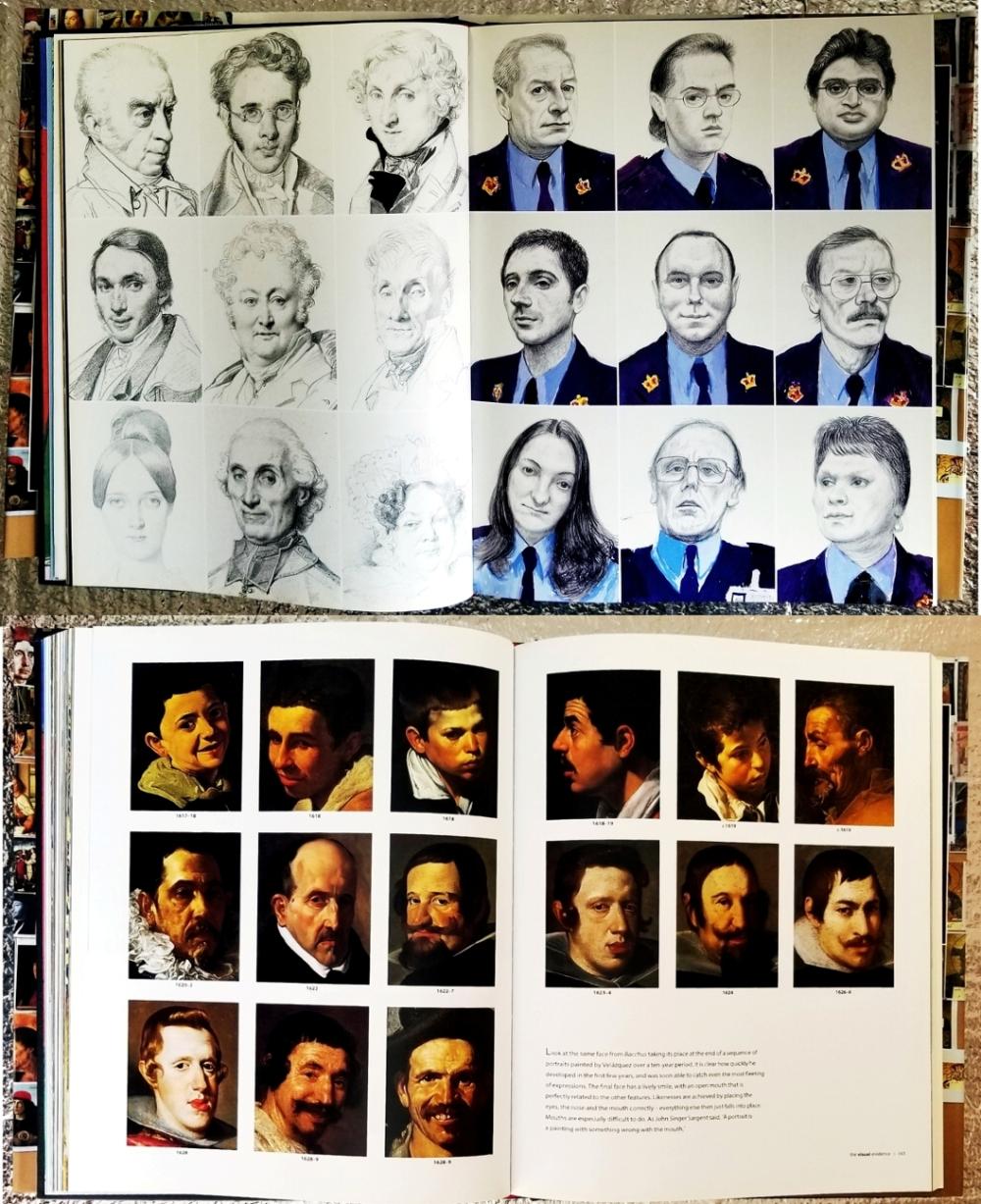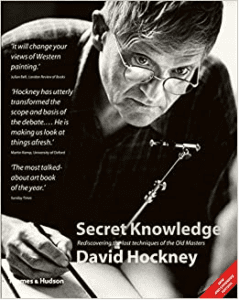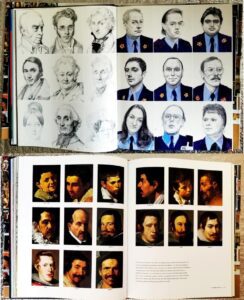
 Sam Vangheluwe
Sam Vangheluwe
“This book is not just about the past and the secret techniques of the artists; it is also about now and the future; the way we see images, and, perhaps, ‘reality’ itself.”
David Hockney
On a windy yet sunny afternoon, a child lies on his bed daydreaming. The bed is placed along the window, which faces south. Outside, the clouds are rushing along against a brilliant blue sky. Then, a miracle occurs. On the ceiling directly above the child a round patch of light appears, featuring clouds rushing along a blue sky. The spectacle is delicate, precious and mesmerizing.
This is how the miracle came about: on the sunny window sill lay a round plastic box with a mirror on one side (for the life of me, I cannot remember the mirror being convex or concave). How or why, I never found out, but the mirror distinctly reflected a circular section of the sky, with the movement of the clouds, onto the ceiling. Soon the light changed, and the projection ceased, never to be reproduced.
This episode of my childhood I recalled when reading about optics in David Hockney’s Secret Knowledge. As far as I know, it is my only first-hand experience with a camera obscura – apart from photographic cameras, or my very own organ of sight.
The optical projection of images reminds me of the set-up of Plato’s Cave in the Republic: people are imprisoned in it, chained so they can only see the wall of the cave. Behind them is a fire, and between them and the fire, people carrying puppets, whose shadows are cast upon the cave wall. The prisoners only see these more or less distorted shadows, yet believe them to be reality: they are not aware of a reality outside of the cave. Most humans remain in the cave and know no better than that the shadows are reality. Very few are the artists that project the shadows using man-made fire. Only a true philosopher can escape the cave.
Some twenty years ago now, the painter David Hockney opened a Pandora’s camera, with the publication of his Secret Knowledge.
To tell the truth, it took me all that time to discover Secret Knowledge. Why? I had by that time resolutely chosen the path of rejecting photography as a basis for my painting. In earlier days, I had made some forays into using photography in painting, but they left me fundamentally unhappy and suspicious. It felt too easy, too docile an acceptance of photographic ‘reality’ – the shadows on the cave wall. I was not principally opposed to the thesis that (some) painters throughout art history had used optics, but my interests lay elsewhere, and Secret Knowledge seemed to propose a line of inquiry opposed to my own. When, some years later, in a radio interview about Secret Knowledge, I heard Hockney pleading against the monocular vision (of the lens) in favor of binocular (human) vision, stating that the photographic image does not equal reality, I was confused. By that time, painters in Belgium and Europe in search of ‘subject matter’ were happily taking snapshots, or leafing through magazines in search of ready-made images of ‘reality’, to be projected onto canvas. Anything else was out. Painting was no longer the ever-unsuccessful hunt for reality, for meaning, but instant capture. Monocular reality tastefully copied onto canvas, with a ready-made back-story for ‘meaning’ – why complicate things? Some even grouped the epigones of photo-based painting under the header of ‘New European Painting’ (see NAE volume 36 no.2 Nov/Dec 2021). On the occasion of the recent double exhibition of David Hockney in Brussels (see the previous issue of NAE), they were there, the New European (Belgian) Painters, eager to be associated with Hockney, for endorsement, to share a bit of the light radiating from the man who so intensively experimented with photography/optics.
Why then, was I in agreement with Hockney? Had Secret Knowledge not promoted this impoverished, this pitiful reduction of reality, of painting?
So, after far too long a lapse, I finally read Secret Knowledge.
Do not expect a regular book review. Do not expect me to stick my oar into the disputes of those who fiddle about with vanishing points, optical instruments or historical sources. The few critical reviews that I read, to me seem petty, and deviating from the main argument. I for one am not horrified that ‘raw painterly talents’ are unmasked as ‘cheats’. My aim is the put some – to my mind – important questions to the fore.

Secret Knowledge is divided into
(1) the visual evidence;
(2) the textual evidence;
(3) the correspondence.
It is driven by Hockney’s limitless curiosity, and his keen painter’s eye. As the artist himself puts it: “My concern is not really with ‘art history’ as such – it is with the history of making images. Art history is not usually interested in these practical questions.”
Painting and drawing, to use Hockney’s straightforward terminology, involve ‘eyeballing’ (using hand and eye alone) and ‘groping’ for the form one sees. Optics, e.g. the camera lucida and obscura, mirrors and lenses, are a means of bypassing this eyeballing and groping. Hockney’s thesis is that from the early 15th century, many western painters used optics – mirrors and/or lenses, to project living images.
The seed for Secret Knowledge was sown with the 1981 ‘Before Photography’ exhibition at the MOMA, which implied that hardly anyone had made use of optics before 1839. Later on, based on his hunch that Ingres had (at times) used a camera lucida, Hockney drew hundreds of portraits using this optical device, from 1999 onwards. In the visual evidence (part I), he compares paintings from the early 15th and following centuries, in their ‘depiction’ of clothes, armour, angels’ wings, texture, foreshortened objects, focus, perspective, portraiture. He explores the use of the camera lucida and obscura, composition, the collage-effect, mirrors and lenses, lighting, projection, underdrawing, facial expression, body proportion, etc.
The merits of Secret Knowledge are undeniable. Hockney directs the viewer’s gaze, makes you question what you see, and the way you contemplate. He offers a plausible explanation of aspects of historical paintings that might for a long time have niggled the viewer, but were left unexplained.
Pages 184-185 reproduce a hand-drawn timeline, starting in 1400. The straight red line is the lens-based image, the wandering green line represents the ‘eyeballing’ tradition. What surprises and excites me most is not so much the early and sustained use of optics in painting, is the realization that it came to an abrupt end around 1870, with Manet, Cézanne, Cubism, and the rise of modernism. A simple fact. Moreover, Hockney’s conclusion that since computer manipulation in the 1970s, “it’s no longer possible to believe that a photograph […] is objective and true.”
In the few pages following this, I find what – to me – is the core of Hockney’s message: the opposition of monocular vision (of the lens), as opposed to binocular or human vision: “two eyes, two viewpoints, and therefore doubt.” I can hardly imagine anyone but a painter, capable of seeing that at a distance, Caravaggio’s basket of fruit becomes more difficult to see, whereas Cézanne’s apples “come out at you”: they occupy the viewer’s space. I cannot think of an art historian who would offer this ‘vision at a distance’ as evidence in support of a thesis. I reckon few art historians truly understand why painters spend so much time backing away from their work, to peer at it from a distance.
A painting is not an iconographical catalogue, whatever art historians might believe. Think of every instance where paintings are shown and analyzed: tv-documentaries, museum audio guides, Ultra High Resolution photos of masterpieces – have you ever seen anything but close-up shots leisurely traveling over the painting’s surface? Is the viewer ever invited to back up, and see? Is contemplation of painting ever anything but the contemplation of the minutest detail? How can Cézanne’s apples ever “occupy the viewer’s space”, if the various guides draw him to the details, if any ‘recul’ is impossible due to the throngs of visitors, armed with audio guides, apps, cameras?
In first instance, this backing up helps the painter to see ‘if the painting holds’: if it doesn’t, it becomes increasingly ‘unclear’ – if it does hold, the painting comes out at you. It then no longer “reduces the viewer to a mathematical point, fixing him to a particular spot in place and time.”
In fact, the painter peering at his work from a distance, what else is he looking out for, but the genesis of a viable reality? Not an imitation of an assumed reality, but the coming into being of an entirely new one?
Is that why, without any premeditation, I feel greater affinity, in the main, with those painters who did not use optics, who ‘eyeballed’ and ‘groped’? For Rubens over Caravaggio, for example. Hockney himself provides a masterful comparison of Caravaggio’s Entombment with Rubens’ copy of it – to Caravaggio’s disadvantage. Could it be that Caravaggio, using optics, copied two dimensions (and ‘collaged’ them), whereas Rubens’ universe is three-dimensional and ‘shimmering with life’? What is the significance of the fact that painters who were into optics, often did not draw at all? After all, Hockney himself regrets the abandonment of drawing in art schools: “giving up drawing is leaving everything to photography, which isn’t going to be that interesting.”
Hockney repeatedly states that optics are a means: “Optical devices are just tools. They don’t make marks, they don’t make the painting. You can draw using optical devices – and it actually is drawing, that is, an imaginative treatment of what you’re dealing with. It’s not just tracing something. In any case, I’m not suggesting that these artists projected a whole picture, then just traced it. That’s not how it was done at all.” I agree that it may be an ‘imaginative treatment’, but it is not necessarily or automatically so. Personally, I fail to see the ‘imagination’ in the examples he reproduces of Warhol’s traced drawings, for example. As I see it, Warhol merely traced a photo. In a benevolent, or art-historical mood, one could allow that Pop Art at least expressed or ‘commented upon’ the 20th century proliferation of photography and printed matter. Current monocular photo-based painting, i.e. ‘New European Painting’, does not even do that. If anything, it aggravates the divorce between man and world: it “reduces the viewer to a mathematical point.” It downsizes the chaos of the world with its countless realities, to a photographic catalogue from which images are selected as ‘subject matter’ for paintings.
As Hockney states, Cubism and subsequent modernism opened up the ways we see the world. Once again, reality was the hunt and not the capture. “The lessons of Cézanne were seen by a few at the beginning of the 20th century and seem now on their way to being lost at the beginning of the 21st century.” It is possible that “Cubism as practised by its originators […] has not really been developed.” To have Cubism lead to ‘abstract’ painting, as conventional art history suggests, I agree “runs into problems.” However, it cannot be denied that abstract painting – the best of it – pursued the hunt. Unlike Impressionism, Expressionism, Surrealism, it did not presuppose the presence of a sacred reality, to be captured, deformed, or peeked at through the keyhole.
Throughout his long career, Hockney has not been a lover of ‘abstract’ painting. For a good while it dominated the art world, and in the struggle for recognition between ‘abstract’ and ‘figurative’ painters, Hockney belonged to a minority. At its best, however, abstract painting embraced the prolific pandemonium of the world – it did not attempt to mimic an (photographic) image of it, it did not strive to ‘re-present’ the world, but ventured to offer an ‘equivalence’.

As Hockney himself says: “[Photography] makes [the world] look very, very dull. Yet now we’re moving back to all the stuff that modernism moved away from. We live in an age when vast numbers of images are made that do not claim to be art. They claim something much more dubious. They claim to be reality.”
The images ‘that do not claim to be art’ are now the sacred reality for contemporary painting. A warehouse of visual props. A summary overview of the contemporary landscape of painting reveals a dismal paradigm. Millions of painters, amateurs and professionals alike, art school students, graffiti artists, ‘realist’ painters from all continents, do not face the world that is around and inside them, they do not “eyeball” or “grope”: their default setting is to bypass their true connection with the world, and grab a shadow of it – the photographic image, and somehow copy that. Like tracing a shadow on the wall of Plato’s cave, and hoping it to be reality. The main alternative is a particularly anodyne and decorative avatar of ‘abstract’ painting, blatantly ornamental, utilitarian and commercial. No concern with any reality whatsoever. So it is either cold feet, or laziness.
As the reader may have gathered by now, I do not naturally share Hockney’s optimism. Without doubt, copying/tracing a photograph does not equal drawing through the camera lucida, the camera lucida must differ in use from the camera obscura, the latter does not equal projecting a whole image onto paper or canvas and tracing it. I sense that all of these techniques involve a greater or lesser degree of ‘imaginative treatment’. But I am still unsure if they can ever equal ‘eyeballing’ and ‘groping’.
I too suspect that photography is done for. We may think we know what the world looks like, but we don’t: “Most people feel that the world looks like the photograph. I’ve always assumed that the photograph is nearly right, but that little bit by which it misses makes it miss by a mile. This is what I grope at.”
Ever an optimist, Hockney is excited about the future of painting: “Photography is just a blip in a longer history. Now it’s coming to an end. We are moving out of what we thought photography was and back to painting.”
How “the computer can now destroy [the] tyranny [of photography]” , is verily witnessed by Hockney’s recent work. One cannot but surmise an ongoing development of digital drawing and painting. However, the future of painting surely cannot depend solely on the computer, as the future of drawing must not depend on the use of optical devices.
If painting is to have a future, it will surely require painters to at the very least question photographic reality. It will require a whole lot more eyeballing and groping, and an uncomfortable amount of awkwardness. It will have to impeach photography and reinstate doubt.
Voilume 36 no 4 March / April 2022

